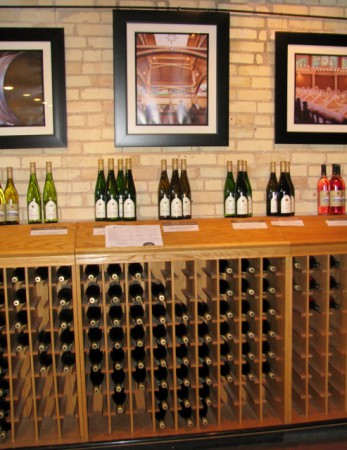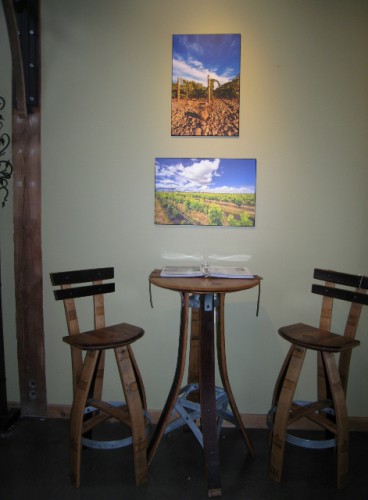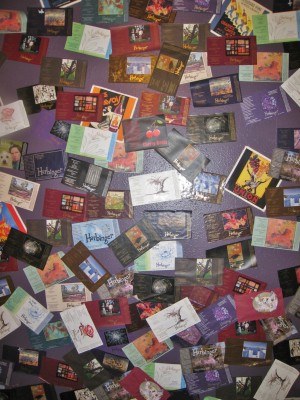After visiting the Mission Point Lighthouse, we got back on the road and headed back toward town, deciding to stop along the way at Brys Estate Winery. It was recommended by the server at Douglas Valley Winery, so I was curious to try it. I was surprised by how large Brys Estate is – it started as a retirement project and the winery now produces several thousand cases annually. The tasting is unique – instead of bellying up to the tasting bar, they have visitors going through four different tasting stations. It seemed like we were at a special event, but apparently that’s just how they do their tasting now.

Brys Estate Winery
At each station we chose between two wines; Jon and I selected different wines at each station so we could get to sample all of them. The wines were all good, ranging from Rieslings to Cabernet Franc to Pinot Noir, but nothing stood out in my memory as amazing. Their servers were all friendly and knowledgeable, but it was awkward at the end. After we finished at the last station, we ended up back in the main tasting room. If you want to buy wine, you have to find it yourself on their ‘wall o’ wine’, and it just seemed kind of impersonal.

The Brys Estate Outdoor Chairs – they would be heavenly on a cold day.
We dropped by a brewery on the Old Mission Peninsula next, hoping to get some lunch and a beer, but the place was crawling and the wait was going to be 90 minutes! Umm… no thanks! So we headed back into town to see what we could find at our next stop, Grand Traverse Commons.
The Grand Traverse Commons is a large retail/housing development that redeveloped the old Traverse City State Hospital. The hospital was founded in 1881, and opened to patients in 1885. It was an asylum for patients with mental illnesses, although at times its mission was expanded to provide care for patients with tuberculosis, polio, influenza and diphtheria.

The Front of the Main Building at Grand Traverse Commons
Many of the patients hospitalized there were able to function on varying levels – at the time it was commonplace to institutionalize people with mental illnesses that would not typically result in hospitalization today; illnesses like depression, bipolar disorder, post-partum depression or anxiety disorders.
Long before drug therapy was commonplace, the hospital set about to try to provide cutting edge therapy that helped people with mental illness be productive within the hospital. Restraint devices like straightjackets were prohibited. The first superintendent, Dr. James Decker Munson, developed a “beauty is therapy” program. He believed that beauty could be therapeutic, so the hospital had greenhouses to produce flowers year round. Additionally, he developed a farm that allowed the hospital to be self-sustaining, and also allowed many of the patients to have jobs that contributed to feelings of self-worth. The farm raised milk cows, beef cows, pigs, chickens and horses, and farmed vegetables.

The Spires of the Main Building at Grand Traverse Commons
The hospital population slowly declined due to the changes that came about in the mental health system that eliminated institutionalization as an option for all but the most severely affected individuals, and the Traverse City State Hospital closed its doors in 1989. Redevelopment came slowly, but Building 50 – the main administration building of the hospital, has now been redeveloped into a multi-use building, with shops, restaurants and condos.
We found an Italian restaurant called Trattoria Stella and got some lunch. I had the mushroom soup (fantastic!) and a risotto with fried egg, chives, sweet pea, rosemary, Parmesan and cream. I had high hopes for the risotto but it was WAY too salty… I also had the Black Star Farms sparkling wine, and loved it. Jon had the minestrone soup (he loved it) and a beet salad with mozzarella, onions and kalamata olives that was delicious as well. He paired his with a Dark Horse Brewery Crooked Tree IPA. After lunch, we wandered around the grounds for a little while; Jon was a sport to let me take photos of the redeveloped buildings and the still abandoned ones, even though he was freezing.

Jon’s Beet Salad at Trattoria Stella

Features on an unrestored building at Grand Traverse Commons
While we were at the Grand Traverse Commons, we decided to check out the Black Star Tasting room as well. You could opt for a wine tasting or a distilled spirits tasting. I picked the wine, Jon picked the spirits. I found several that I enjoyed and ended up buying two wines to take home, including their Blushed sparkling wine. Jon purchased a bottle of craft Peninsula Gin from Grand Traverse Distillery.

Wine Bottles at Black Star Farms Tasting Room
And with that, we made our way back to the car to find our way to my aunt and uncle’s house. We had a couple of hours of driving ahead of us, according to Google Maps, so I was a bit surprised to find that our GPS was telling me it would take almost 4 hours to get to my aunt’s house! There didn’t seem to be any traffic! I had been driving along in this state of confusion for almost a half an hour when I suddenly realized that the day before I had set the route preferences to avoid highways, so we could see the more scenic route. But now we wanted to go the more direct way. OOPS!
Once we changed the settings, our arrival time moved up significantly! We got to my aunt and uncle’s house just after the rest of the family finished up dinner, so we were able to get some food and spend some time catching up with the family. The next day there was a family reunion, but our brief tour of Michigan had drawn to a close…




























